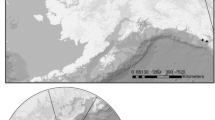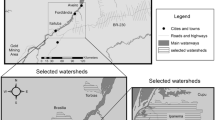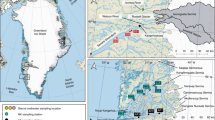Abstract
We report estimates of mercury (Hg) flux to the sediments of Lake Tahoe, California–Nevada: 2 and 15–20 µg/m2/year in preindustrial and modern sediments, respectively. These values result in a modern to preindustrial flux ratio of 7.5–10, which is similar to flux ratios recently reported for other alpine lakes in California, and greater than the value of 3 typically seen worldwide. We offer plausible hypotheses to explain the high flux ratios, including (1) proportionally less photoreduction and evasion of Hg with the onset of cultural eutrophication and (2) a combination of enhanced regional oxidation of gaseous elemental Hg and transport of the resulting reactive gaseous Hg to the surface with nightly downslope flows of air. If either of these mechanisms is correct, it could lead to local/regional solutions to lessen the impact of globally increasing anthropogenic emissions of Hg on Lake Tahoe and other alpine ecosystems.



Similar content being viewed by others
References
Alpers, C. N., Hunerlach, M. P., May, J. T., & Hothem, R. L. (2005). Mercury contamination from historical gold mining in California. Fact Sheet 2005-3014-1.1. Sacramento: U.S. Geological Survey.
Amyot, M., Mierle, G., Lean, D. R. S., & McQueen, D. J. (1994). Sunlight-induced formation of dissolved gaseous mercury in lake waters. Environmental Science & Technology, 28, 2366–2371.
Appleby, P. G. (2001). Chronostratigraphic techniques in recent sediments. In W. M. Last & J. P. Smol (Eds.), Tracking environmental change using lake sediments, basin analysis, coring, and chronological techniques, Vol. 1 (pp. 171–203). Dordrecht: Kluwer Academic.
Bergquist, B. A. & Blum, J. D. (2007). Mass-dependent and -independent fractionation of Hg isotopes by photoreduction in aquatic systems. Science, 318, 417–420.
Blais, J. M., Charpentié, S., Pick, F., Kimpe, L. E., St. Amand, A., & Regnault-Roger, C. (2006). Mercury, polybrominated diphenyl ether, organochlorine pesticide, and polychlorinated biphenyl concentrations in fish from lakes along an elevation transect in the French Pyrénées. Ecotoxicology and Environmental Safety, 63, 91–99.
California Air Resources Board. (2006). Lake Tahoe atmospheric deposition study final report. Sacramento: California Environmental Protection Agency.
Calvert, J. G. & Lindberg, S. E. (2005). Mechanisms of mercury removal by O3 and OH in the atmosphere. Atmospheric Environment, 39, 3355–3367.
Chandra, S., Vander Zanden, M. J., Heyvaert, A. C., Richards, B. C., Allen, B. C., & Goldman, C. R. (2005). The effects of cultural eutrophication on the coupling between pelagic primary producers and benthic consumers. Limnology and Oceanography, 50, 1368–1376.
Crusius, J. & Anderson, R. F. (1995). Evaluating the mobility of Cs-137, Pu-239+240 and Pb-210 from their distributions in laminated lake sediments. Journal of Paleolimnology, 13, 119–141.
Davis, R. B., Anderson, D. S., Dixit, S. S., Appleby, P. G., & Schauffler, M. (2006). Responses of two New Hampshire (USA) lakes to human impacts in recent centuries. Journal of Paleolimnology, 35, 669–697.
Draut, A. E., Bothner, M. H., Field, M. E., Reynolds, R. L., Cochran, S. A., Logan, J. B., et al. (2009). Supply and dispersal of flood sediment from a steep, tropical watershed: Hanalei Bay, Kaua’i, Hawai’i. Geological Society of America Bulletin, 121, 574–585.
Eakins, J. D. & Morrison, R. T. (1978). A new procedure for the determination of lead-210 in lake and marine sediments. International Journal of Applied Radiation and Isotopes, 29, 531–536.
Fitzgerald, W. F. & Lamborg, C. H. (2004). Geochemistry of mercury in the environment. In B. S. Lollar, H. D. Holland & K. K. Turekian (Eds.), Environmental geochemistry, treatise on geochemistry (Vol. 9, pp. 107–148). Oxford: Elsevier.
Goldman, C. R. (1998). Multiple environmental stresses on the fragile Lake Tahoe ecosystem. In J. J. Cech Jr., B. W. Wilson & D. G. Crosby (Eds.), Multiple stresses in ecosystems (pp. 41–52). Boca Raton: Lewis Publishers.
Heiri, O., Lotter, A. F., & Lemcke, G. (2001). Loss on ignition as a method for estimating organic and carbonate content in sediments: Reproducibility and comparability of results. Journal of Paleolimnology, 25, 101–110.
Heyvaert, A. C. (1998). The biogeochemistry and paleolimnology of sediments from Lake Tahoe, California-Nevada. Ph.D. dissertation. University of California: Davis, CA
Heyvaert, A. C., Reuter, J. E., Slotton, D. G., & Goldman, C. R. (2000). Paleolimnological reconstruction of historical atmospheric lead and mercury deposition at Lake Tahoe, California-Nevada. Environmental Science & Technology, 34, 3588–3597.
Hyne, N. J., Chelminski, P., Court, J. E., Gorsline, D. S., & Goldman, C. R. (1972). Quaternary history of Lake Tahoe, California-Nevada. Geological Society of America Bulletin, 83, 1435–1448.
Kim, J. G. & Rejmánková, E. (2001). The paleoecological record of human disturbance in wetlands of the Lake Tahoe basin. Journal of Paleolimnology, 25, 437–454.
Kim, J. G., Rejmánková, E., & Spanglet, H. J. (2001). Implications of a sediment-chemistry study on subalpine marsh conservation in the Lake Tahoe basin, USA. Wetlands, 21, 379–394.
Koide, M., Soutar, A., & Goldberg, E. D. (1972). Marine geochronology with 210Pb. Earth and Planetary Science Letters, 14, 442–446.
Lamborg, C. H., Fitzgerald, W. F., Damman, A. W. H., Benoit, J. M., Balcom, P. H., & Engstrom, D. R. (2002). Modern and historic atmospheric mercury fluxes in both hemispheres: Global and regional mercury cycling implications. Global Biogeochemical Cycles, 16, 1104. doi:10.1029/2001GB001847.
Landers, D. H., Simonich, S. L., Jaffe, D. A., Geiser, L. H., Campbell, D. H., Schwindt, A. R., et al. (2008). The fate, transport and ecological impacts of airborne contaminants in western national parks (USA). EPA/600/R-07/138. Corvallis: U.S. Environmental Protection Agency.
Landis, M. S., Lynam, M. M., & Stevens, R. K. (2005). The monitoring and modelling of Hg species in support of local, regional, and global modelling. In N. Pirrone & K. R. Mahaffey (Eds.), Dynamics of mercury pollution on regional and global scales (pp. 123–151). New York: Springer.
Lindberg, S., Bullock, R., Ebinghaus, R., Engstrom, D., Feng, X., Fitzgerald, W., et al. (2007). A synthesis of progress and uncertainties in attributing the sources of mercury in deposition. Ambio, 36, 19–32.
Lyman, S. N., Gustin, M. S., Prestbo, E. M., & Marsik, F. J. (2007). Estimation of dry deposition of atmospheric mercury in Nevada by direct and indirect methods. Environmental Science & Technology, 41, 1970–1976.
Moran, P. W., Aluru, N., Black, R. W., & Vijayan, M. H. (2007). Tissue contaminants and associated transcriptional responses in trout liver from high elevation lakes of Washington. Environmental Science & Technology, 41, 6591–6597.
Murphy, J. G., Day, D. A., Cleary, P. A., Wooldridge, P. J., & Cohen, R. C. (2006). Observations of the diurnal and seasonal trends in nitrogen oxides in the western Sierra Nevada. Atmospheric Chemistry and Physics, 6, 5321–5338.
Osleger, D. A., Heyvaert, A. C., Stoner, J. S., & Verosub, K. L. (2009). Lacustrine turbidites as indicators of Holocene storminess and climate: Lake Tahoe, California and Nevada. Journal of Paleolimnology, 42, 103–122.
National Atmospheric Deposition Program. (2008). NADP Program Office. Champaign: Illinois State Water Survey.
Nriagu, J. O. (1994). Mercury pollution from the past mining of gold and silver in the Americas. Science of the Total Environment, 149, 167–181.
Pacyna, E. G., Pacyna, J. M., Steenhuisen, F., & Wilson, S. (2006). Global anthropogenic mercury emission inventory for 2000. Atmospheric Environment, 40, 4048–4063.
Palmer, D. F., Henyey, T. L., & Dodson, R. E. (1979). Paleomagnetic and sedimentological studies at Lake Tahoe, California-Nevada. Earth and Planetary Science Letters, 46, 125–137.
Renberg, I. & Hansson, H. (2008). The HTH sediment corer. Journal of Paleolimnology, 40, 655–659.
Rydberg, J., Gälman, V., Renberg, I., Bindler, R., Lambertsson, L., & Martínez-Cortizas, A. (2008). Assessing the stability of mercury and methylmercury in a varved lake sediment deposit. Environmental Science & Technology, 42, 4391–4396.
Sanders, R. D., Coale, K. H., Gill, G. A., Andrews, A. H., & Stephenson, M. (2008). Recent increase in atmospheric deposition of mercury to California aquatic systems inferred from a 300-year geochronological assessment of lake sediments. Applied Geochemistry, 23, 399–407.
Schuster, P. F., Krabbenhoft, D. P., Naftz, D. L., Cecil, L. D., Olson, M. L., Dewild, J. F., et al. (2002). Atmospheric mercury deposition during the last 270 years: A glacial ice core record of natural and anthropogenic sources. Environmental Science & Technology, 36, 2303–2310.
Schwindt, A. R., Fournie, J. W., Landers, D. H., Schreck, C. B., & Kent, M. L. (2008). Mercury concentrations in salmonids from western U.S. national parks and relationships with age and macrophage aggregates. Environmental Science & Technology, 42, 1365–1370.
Selin, N. E., Jacob, D. J., Park, R. J., Yantosca, R. M., Strode, S., Jaeglé, L., et al. (2007). Chemical cycling and deposition of atmospheric mercury: Global constraints from observations. Journal of Geophysical Research, 112, D02308. doi:10.1029/2006JD007450.
Selin, N. E., Jacob, D. J., Yantosca, R. M., Strode, S., Jaeglé, L., & Sunderland, E. M. (2008). Global 3-D land-ocean-atmosphere model for mercury: Present-day vs. pre-industrial cycles and anthropogenic enrichment factors for deposition. Global Biogeochemical Cycles, 22, GB2011. doi:10.1029/2007GB003040.
Sillman, S., Marsik, F. J., Al-Wali, K. I., Keeler, G. J., & Landis, M. S. (2007). Reactive mercury in the troposphere: Model formation and results for Florida, the northeastern United States, and the Atlantic Ocean. Journal of Geophysical Research, 112, D23305. doi:10.1029/2006JD008277.
Smol, J. P. (1992). Paleolimnology: An important tool for effective ecosystem management. Journal of Aquatic Ecosystem Health, 1, 49–58.
Southworth, G., Lindberg, S., Hintelmann, H., Amyot, M., Poulain, A., Bogle, M., et al. (2007). Evasion of added isotopic mercury from a northern temperate lake. Environmental Toxicology and Chemistry, 26, 53–60.
Strode, S., Jaeglé, L., & Selin, N. E. (2009). Impact of mercury emissions from historic gold and silver mining: Global modeling. Atmospheric Environment, 43, 2012–2017.
Swain, E. B., Engstrom, D. R., Brigham, M. E., Henning, T. A., & Brezonik, P. L. (1992). Increasing rates of atmospheric mercury deposition in midcontinental North America. Science, 257, 784–787.
Swartzendruber, P. C., Jaffe, D. A., Prestbo, E. M., Weiss-Penzias, P., Selin, N. E., Park, R., et al. (2006). Observations of reactive gaseous mercury in the free troposphere at the Mount Bachelor Observatory. Journal of Geophysical Research, 111, D24301. doi:10.1029/2006JD007415.
Van Metre, P. C. & Fuller, C. C. (2009). Dual-core mass-balance approach for evaluating mercury and 210Pb atmospheric fallout and focusing to lakes. Environmental Science & Technology, 43, 26–32.
Wang, Y. & Jacob, D. J. (1998). Anthropogenic forcing on tropospheric ozone and OH since preindustrial times. Journal of Geophysical Research, 103, 31123–31135.
Watras, C. J., Bloom, N. S., Hudson, R. J. M., Gherini, S., Munson, R., Claas, S. A., et al. (1994). Sources and fates of mercury and methylmercury in Wisconsin lakes. In C. J. Watras & J. W. Huckabee (Eds.), Mercury Pollution: Integration and Synthesis (pp. 153–177). Boca Raton: Lewis Publishers.
Acknowledgements
Brant Allen, Aaron Roberts, Brent Yelle, and Michael Casso helped with field and lab work. John Crusius and Nelson O’Driscoll gave useful advice for sediment and evasion modeling, respectively. Funding was provided by Miami University, EPA-STAR, the Postdoctoral Scholar Program at Woods Hole Oceanographic Institution, and the USGS.
Author information
Authors and Affiliations
Corresponding author
Electronic Supplementary Material
Supplementary material for this manuscript includes (1) a table of quality assurance results for total Hg determinations, (2) figures of Ti, organic content, and 137Cs in sediment cores from Lake Tahoe, (3) information about evasion modeling, and (4) an analysis of washout curves from seven sites in California and Nevada.
Electronic Supplementary Material
(PDF 520 kb)
Rights and permissions
About this article
Cite this article
Drevnick, P.E., Shinneman, A.L.C., Lamborg, C.H. et al. Mercury Flux to Sediments of Lake Tahoe, California–Nevada. Water Air Soil Pollut 210, 399–407 (2010). https://doi.org/10.1007/s11270-009-0262-y
Received:
Accepted:
Published:
Issue Date:
DOI: https://doi.org/10.1007/s11270-009-0262-y




